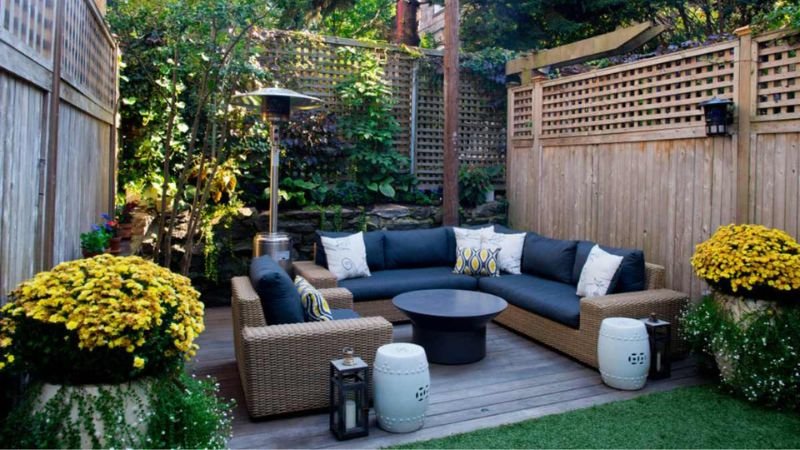As the temperatures rise, it’s time to revamp your yard with the perfect summer landscaping strategies. Keeping your lawn and garden vibrant during the hottest months can be challenging, but with a few simple adjustments, you can maintain a lush, healthy outdoor space all season long.
From watering wisely to selecting heat-resistant plants, summer landscaping doesn’t have to be a daunting task. Whether you’re a seasoned gardener or a beginner, these top 10 tips will help you create a stunning yard that thrives under the sun. Ready to transform your outdoor space? Let’s dive in!
Top 10 Summer Landscaping Tips For You
1. Choose Heat-Tolerant Plants
One of the most effective ways to ensure your landscape thrives during the summer is by selecting heat-tolerant plants. These plants are adapted to withstand higher temperatures and require less water, making them perfect for hot climates. Examples include succulents, cacti, ornamental grasses, and native perennials like lavender and coneflowers. They are not only drought-resistant but also visually appealing, adding texture and color to your garden.
Opting for these resilient plants minimizes the need for constant watering and maintenance, which is essential during the scorching summer months. Incorporating a mix of these plants will also enhance the biodiversity of your garden, making it both eco-friendly and beautiful.
Also Read:- Colorful Plants To Brighten Up Your Landscape
2. Water Early and Deeply
The timing and technique of watering can significantly affect the health of your garden in the summer. Watering early in the morning, before the heat of the day sets in, helps prevent evaporation and ensures that plants can absorb moisture efficiently. A deep watering strategy, where you water less frequently but more thoroughly, encourages plants to develop deep root systems, which helps them access moisture even when the topsoil is dry.
A common mistake is watering the garden in the evening, which can lead to fungal growth as plants remain wet overnight. Implementing a morning watering routine is a smart, water-saving solution for healthy summer landscaping.
3. Mulch to Retain Moisture
Mulching is a critical step in keeping your garden healthy during the summer. By adding a layer of organic material like wood chips, straw, or compost to your garden beds, you help retain moisture in the soil, reduce weed growth, and regulate soil temperature. Mulch acts as a protective barrier, preventing the sun from drying out the soil too quickly and reducing the need for frequent watering.
Additionally, as organic mulch breaks down over time, it improves soil fertility, providing essential nutrients to your plants. Applying a 2-3 inch layer of mulch around your plants will protect them from the heat and promote healthy growth throughout the summer.
4. Mow Your Lawn High
During summer, it’s essential to adjust your lawn-mowing routine to promote a healthier yard. Raising your lawnmower blade to a higher setting encourages longer grass growth, which helps shade the soil and retain moisture. Taller grass has deeper roots, making it more drought-resistant and less prone to heat stress. Mowing too short can weaken your lawn, leaving it vulnerable to weeds and scorching under the summer sun.
Aim for a grass height of about 3-4 inches to maintain a lush, green lawn even in the hottest months. By adjusting your mowing habits, you ensure your lawn stays resilient and well-nourished throughout summer.
5. Focus on Smart Irrigation
Efficient water use is critical for summer landscaping, especially in regions where water restrictions may be in place. A smart irrigation system, such as a drip or soaker hose system, delivers water directly to the base of plants, minimizing evaporation and ensuring that water reaches the roots where it’s needed most. You can also install a rain sensor on your irrigation system to prevent overwatering on days when rain is in the forecast.
Automating your watering schedule with a smart controller allows you to conserve water while maintaining a healthy, vibrant garden. This approach is both environmentally friendly and cost-effective, helping you save on water bills.
6. Use Shade Strategically
Shade is a valuable asset in summer landscaping, especially in protecting delicate plants from the intense heat. If you have large trees or pergolas, make use of the natural shade they provide. For areas where shade is scarce, consider using temporary solutions like shade cloths or outdoor umbrellas to protect vulnerable plants during peak sunlight hours.
You can also strategically plant taller shrubs and trees to create natural shaded areas over time. By adding shade to your landscape, you reduce water evaporation and create cooler microclimates, which help both plants and humans enjoy the garden more comfortably.
7. Incorporate Native Plants
Native plants are naturally adapted to your local climate, which makes them an ideal choice for summer landscaping. These plants are accustomed to local weather conditions, pests, and soil types, meaning they require less water, fertilizer, and care compared to non-native species.
Native plants also attract beneficial wildlife like pollinators, such as bees and butterflies, which support the health of your garden. By incorporating native plants, you reduce your garden’s environmental impact while creating a beautiful, sustainable landscape. Research which plants thrive in your region to ensure a robust and eco-friendly summer garden.
8. Prune Regularly
Pruning your plants is an essential task for maintaining a healthy garden during the summer. Regular pruning helps to remove dead or diseased branches, encourages new growth, and improves air circulation, which can prevent issues like mold or insect infestations. Summer pruning is particularly beneficial for fruit trees and flowering plants, as it directs the plant’s energy toward fruit or flower production rather than sustaining unnecessary foliage.
Be mindful to prune in the cooler parts of the day, either early morning or late afternoon, to avoid stressing your plants. Proper pruning not only enhances the aesthetic appeal of your garden but also promotes overall plant health.
9. Fertilize Wisely
Fertilization is vital for keeping your landscape healthy during the summer months. However, over-fertilizing can lead to rapid growth that stresses your plants in the heat. Instead, opt for a slow-release fertilizer that gradually provides nutrients over time.
Organic fertilizers, such as compost or fish emulsion, are excellent options as they nourish the soil and improve its structure without the risk of overfeeding. Make sure you adhere to the suggested rates of application in order to prevent nutrient burn. With a balanced fertilization approach, you can ensure your plants have the necessary nutrients to thrive throughout the summer.
Also Read:- Low Maintenance Houseplants For Lazy Gardeners
10. Plan for Future Growth
When designing your summer landscape, it’s important to consider the long-term growth of your plants. Make sure you leave enough space between plants to accommodate their mature size, which will help reduce overcrowding and competition for resources. Overcrowded plants are more susceptible to disease, water stress, and poor air circulation. Planning ahead allows your garden to grow in a healthy, balanced way.
Additionally, consider planting perennial species that will return each year, cutting down on the amount of replanting required. This approach ensures that your garden will be easier to maintain over time, with less effort needed for future summers.
Conclusion
Summer landscaping doesn’t need to be overwhelming. By following these top 10 tips, you can ensure your yard stays vibrant and well-maintained all season long. With proper care, your outdoor space will flourish, giving you more time to relax and enjoy the beauty of summer in your own backyard.
FAQs
What plants are best for summer landscaping?
Choose heat-tolerant plants like succulents, ornamental grasses, and native perennials that can thrive in hot, dry conditions.
How often should I water my lawn in the summer?
Water your lawn early in the morning, 2-3 times a week, to encourage deep root growth and prevent evaporation.



